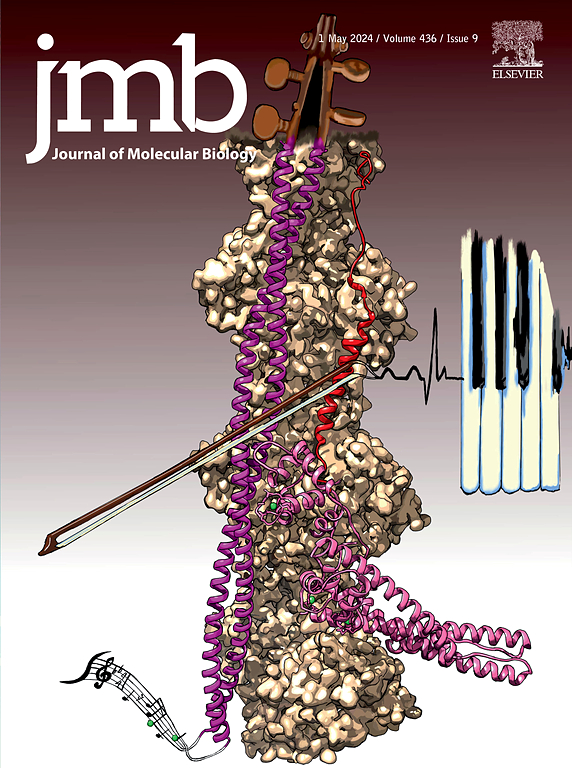ATG9不仅仅是自噬相关蛋白。
IF 4.5
2区 生物学
Q1 BIOCHEMISTRY & MOLECULAR BIOLOGY
引用次数: 0
摘要
自噬蛋白协调吞噬细胞的生物发生,自噬体的形成和成熟。这些蛋白的基因突变可导致自噬失调,自噬体生物发生停滞,导致细胞死亡。ATG9,唯一的跨膜ATG(自噬相关)蛋白控制吞噬细胞的成核。在分子水平上,ATG9已被证明是一种脂质重组酶,能够在脂质双分子层上重新分配脂质。atg9阳性囊泡也可以传递脂质修饰酶来改变膜的脂质组成。这两种功能都是自噬所必需的。然而,ATG蛋白,包括ATG9,在与自噬无关的途径中发挥关键的分子作用。ATG9已被证明在高尔基体、质膜和溶酶体的多种途径中起作用。ATG9也可以在免疫信号传导中发挥重要作用。ATG9阳性囊泡中ATG9的转运对许多这些途径至关重要。在这篇综述中,我们强调了ATG9在自噬和自噬相关途径中的功能,这里被称为“非规范功能”,并总结了ATG9A在细胞稳态中的广泛作用。本文章由计算机程序翻译,如有差异,请以英文原文为准。

ATG9 Not Just an Autophagy Related Protein
Autophagy proteins coordinate the biogenesis of a phagophore, the formation and maturation of an autophagosome. Genetic mutations of these proteins can result in dysregulated autophagy, stalled autophagosome biogenesis, and lead to cell death. ATG9, the sole transmembrane ATG (autophagy related) protein governs the nucleation of the phagophore. At a molecular level ATG9 has been shown to be a lipid scramblase capable of redistributing lipids across the lipid bilayer. ATG9-positive vesicles can also deliver lipid-modifying enzymes to alter the lipid composition of membranes. Both functions are required for autophagy. However, ATG proteins, including ATG9, play key molecular roles in pathways unrelated to autophagy. ATG9 has been shown to function in multiple pathways at the Golgi, plasma membrane, and lysosomes. ATG9 can also play an important role in immune signalling. The trafficking of ATG9 in ATG9-positive vesicles is essential to many of these pathways. In this review we highlight the functions of ATG9 in autophagy and autophagy-unrelated pathways, here referred to as “non-canonical functions”, and summarise the broader role of ATG9A in cell homeostasis.
求助全文
通过发布文献求助,成功后即可免费获取论文全文。
去求助
来源期刊

Journal of Molecular Biology
生物-生化与分子生物学
CiteScore
11.30
自引率
1.80%
发文量
412
审稿时长
28 days
期刊介绍:
Journal of Molecular Biology (JMB) provides high quality, comprehensive and broad coverage in all areas of molecular biology. The journal publishes original scientific research papers that provide mechanistic and functional insights and report a significant advance to the field. The journal encourages the submission of multidisciplinary studies that use complementary experimental and computational approaches to address challenging biological questions.
Research areas include but are not limited to: Biomolecular interactions, signaling networks, systems biology; Cell cycle, cell growth, cell differentiation; Cell death, autophagy; Cell signaling and regulation; Chemical biology; Computational biology, in combination with experimental studies; DNA replication, repair, and recombination; Development, regenerative biology, mechanistic and functional studies of stem cells; Epigenetics, chromatin structure and function; Gene expression; Membrane processes, cell surface proteins and cell-cell interactions; Methodological advances, both experimental and theoretical, including databases; Microbiology, virology, and interactions with the host or environment; Microbiota mechanistic and functional studies; Nuclear organization; Post-translational modifications, proteomics; Processing and function of biologically important macromolecules and complexes; Molecular basis of disease; RNA processing, structure and functions of non-coding RNAs, transcription; Sorting, spatiotemporal organization, trafficking; Structural biology; Synthetic biology; Translation, protein folding, chaperones, protein degradation and quality control.
 求助内容:
求助内容: 应助结果提醒方式:
应助结果提醒方式:


